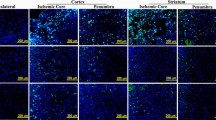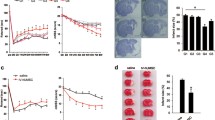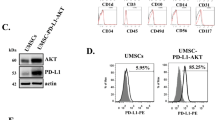Abstract
Mesenchymal stem/stromal cells (MSCs) are spindle-like heterogeneous cell populations with advantageous bidirectional immunomodulatory and hematopoietic support effects. Vascular cellular adhesion molecule-1 (VCAM-1)+ MSCs have been reported to exhibit immunoregulatory and proangiogenic capacities. Here, we studied the effects of VCAM-1+ human umbilical cord (hUC)-MSCs on neuroprotection against cerebral infarction. Sprague–Dawley rats were subjected to middle cerebral artery occlusion (MCAO), and VCAM-1− and VCAM-1+ hUC-MSCs were intravenously injected into the rat 4 h post-MCAO surgery. Thereafter, modified neurological severity scores (mNSS) were determined, and the Morris water maze test, 2,3,5-triphenyltetrazolium chloride (TTC), hematoxylin and eosin (H&E), Nissl, TUNEL staining, and qRT-PCR were conducted. Following induction of oxygen–glucose deprivation/reoxygenation (OGD/R), SH-SY5Y cells were co-cultured with VCAM-1− and VCAM-1+ hUC-MSCs. CCK-8, flow cytometry, ELISA, and western blot analyses were performed in vitro. Compared with VCAM-1− hUC-MSCs, administration of VCAM-1+ hUC-MSCs revealed improved therapeutic efficacy against cerebral infarction in rats, as confirmed by lower mNSS scores and infarct volumes, as well as improved learning and memory capacities. In addition, VCAM-1+ hUC-MSCs exhibited improved efficacy against neurological defects in rats with cerebral infarction, accompanied by inhibition of the NLRP3-mediated inflammatory response. VCAM-1+ hUC-MSC co-culture improved the viability and diminished NLRP3-mediated inflammatory response in OGD/R-treated SH-SY5Y cells. Moreover, NLRP3 overexpression in SH-SY5Y cells prevented the beneficial effects of VCAM-1+ hUC-MSC co-culture. Overall, our findings demonstrated the relevance of VCAM-1+ hUC-MSC-based cytotherapy for preclinical neuroprotection against cerebral infarction.






Similar content being viewed by others
Data availability
All data generated or analysed during this study, together with the additional file, are included in this published article. Meanwhile, the datasets involved in the current study are available from the corresponding author on reasonable request.
Abbreviations
- MSCs:
-
Mesenchymal stem/stromal cells
- hUC-MSCs:
-
Human umbilical cord MSCs
- PSC:
-
Pluripotent stem cells
- NLRP3:
-
NOD-like receptor thermal protein domain-associated protein 3
- ASC:
-
Apoptosis associated speck like protein containing CARD
- VCAM-1:
-
Vascular cellular adhesion molecule-1
- EAM:
-
Experimental autoimmune myocarditis
- DEGs:
-
Differentially expressed genes
- GO:
-
Gene ontology
- mNSS:
-
Modified neurological severity scores
- MCAO:
-
Middle cerebral artery occlusion
- OGD/R:
-
Oxygen-glucose deprivation/reoxygenation
- FCM:
-
Flow cytometry
- NDA:
-
New drug application
- GSEA:
-
Gene set enrichment analysis
- PFA:
-
Paraformaldehyde
- WHO:
-
World Health Organization
- MCA:
-
Middle cerebral artery
- qRT-PCR:
-
Quantitative real-time polymerase chain reaction
- ELISA:
-
Enzyme-linked immunosorbent assay
- sEVs:
-
Small extracellular vesicles
References
Arboix A, Alio J (2012) Acute cardioembolic cerebral infarction: answers to clinical questions. Curr Cardiol Rev 8(1):54–67
who.int.: STEPwise approach to stroke surveillance, 2013. [updated 10 August, 2013; cited 10 August, 2013]. Available at http://www.who.int/chp/steps/stroke/en/. In.; 2013.
Guzik A, Bushnell C: Stroke Epidemiology and Risk Factor Management. Continuum (Minneapolis, Minn) 2017, 23(1, Cerebrovascular Disease):15–39.
Yaggi HK, Concato J, Kernan WN, Lichtman JH, Brass LM, Mohsenin V (2005) Obstructive sleep apnea as a risk factor for stroke and death. N Engl J Med 353(19):2034–2041
Hurford R, Sekhar A, Hughes TAT, Muir KW (2020) Diagnosis and management of acute ischaemic stroke 20(4):304–316
Wu S, Wu B, Liu M, Chen Z, Wang W, Anderson CS, Sandercock P, Wang Y, Huang Y, Cui L et al (2019) Stroke in China: advances and challenges in epidemiology, prevention, and management. The Lancet Neurology 18(4):394–405
Azad TD, Veeravagu A, Steinberg GK (2016) Neurorestoration after stroke. Neurosurg Focus 40(5):E2
Zhang L, Wang H, Liu C, Wu Q, Su P, Wu D, Guo J, Zhou W, Xu Y, Shi L et al (2018) MSX2 Initiates and Accelerates Mesenchymal Stem/Stromal Cell Specification of hPSCs by Regulating TWIST1 and PRAME. Stem Cell Reports 11(2):497–513
Zhao Q, Zhang L, Wei Y, Yu H, Zou L, Huo J, Yang H, Song B, Wei T, Wu D et al (2019) Systematic comparison of hUC-MSCs at various passages reveals the variations of signatures and therapeutic effect on acute graft-versus-host disease. Stem Cell Res Ther 10(1):354
Nombela-Arrieta C, Ritz J, Silberstein LE (2011) The elusive nature and function of mesenchymal stem cells. Nat Rev Mol Cell Biol 12(2):126–131
Huo J, Zhang L, Ren X, Li C, Li X, Dong P, Zheng X, Huang J, Shao Y, Ge M et al (2020) Multifaceted characterization of the signatures and efficacy of mesenchymal stem/stromal cells in acquired aplastic anemia. Stem Cell Res Ther 11(1):59
Wei Y, Zhang L, Chi Y, Ren X, Gao Y, Song B, Li C, Han Z, Zhang L, Han Z (2020) High-efficient generation of VCAM-1(+) mesenchymal stem cells with multidimensional superiorities in signatures and efficacy on aplastic anaemia mice. Cell Prolif 53(8):e12862
Zhang L, Chi Y, Wei Y, Zhang W, Wang F, Zhang L, Zou L, Song B, Zhao X, Han Z (2021) Bone marrow-derived mesenchymal stem/stromal cells in patients with acute myeloid leukemia reveal transcriptome alterations and deficiency in cellular vitality. Stem Cell Res Ther 12(1):365
Hou H, Zhang L, Duan L, Liu Y, Han Z, Li Z, Cao X (2020) Spatio-Temporal Metabolokinetics and Efficacy of Human Placenta-Derived Mesenchymal Stem/Stromal Cells on Mice with Refractory Crohn’s-like Enterocutaneous Fistula. Stem Cell Rev Rep 16(6):1292–1304
Zhao X, Zhao Y, Sun X, Xing Y, Wang X, Yang Q (2020) Immunomodulation of MSCs and MSC-Derived Extracellular Vesicles in Osteoarthritis. Front Bioeng Biotechnol 8:575057
Park HS, Chugh RM, El Andaloussi A, Hobeika E, Esfandyari S, Elsharoud A, Ulin M, Garcia N, Bilal M, Al-Hendy A (2021) Human BM-MSC secretome enhances human granulosa cell proliferation and steroidogenesis and restores ovarian function in primary ovarian insufficiency mouse model. Sci Rep 11(1):4525
Tan TT, Toh WS, Lai RC, Lim SK (2021) Practical considerations in transforming MSC therapy for neurological diseases from cell to EV. Exp Neurol 349:113953
Liu QW, Li JY, Zhang XC, Liu Y, Liu QY, Xiao L, Zhang WJ, Wu HY, Deng KY, Xin HB (2020) Human amniotic mesenchymal stem cells inhibit hepatocellular carcinoma in tumour-bearing mice. J Cell Mol Med 24(18):10525–10541
Xu L, Liu Y, Sun Y, Wang B, Xiong Y, Lin W, Wei Q, Wang H, He W, Wang B et al (2017) Tissue source determines the differentiation potentials of mesenchymal stem cells: a comparative study of human mesenchymal stem cells from bone marrow and adipose tissue. Stem Cell Res Ther 8(1):275
Wei Y, Hou H, Zhang L, Zhao N, Li C, Huo J, Liu Y, Zhang W, Li Z, Liu D et al (2019) JNKi- and DAC-programmed mesenchymal stem/stromal cells from hESCs facilitate hematopoiesis and alleviate hind limb ischemia. Stem Cell Res Ther 10(1):186
Zhang L, Wei Y, Chi Y, Liu D, Yang S, Han Z, Li Z (2021) Two-step generation of mesenchymal stem/stromal cells from human pluripotent stem cells with reinforced efficacy upon osteoarthritis rabbits by HA hydrogel. Cell Biosci 11(1):6
El Omar R, Beroud J, Stoltz JF, Menu P, Velot E, Decot V (2014) Umbilical cord mesenchymal stem cells: the new gold standard for mesenchymal stem cell-based therapies? Tissue Eng Part B Rev 20(5):523–544
Colicchia M, Jones DA, Beirne AM, Hussain M, Weeraman D, Rathod K, Veerapen J, Lowdell M, Mathur A (2019) Umbilical cord-derived mesenchymal stromal cells in cardiovascular disease: review of preclinical and clinical data. Cytotherapy 21(10):1007–1018
Yan J, Liu T, Li Y, Zhang J, Shi B, Zhang F, Hou X, Zhang X, Cui W, Li J et al (2023) Effects of magnetically targeted iron oxide@polydopamine-labeled human umbilical cord mesenchymal stem cells in cerebral infarction in mice. Aging 15(4):1130–1142
Wang W, Ji Z, Yuan C, Yang Y (2021) Mechanism of Human Umbilical Cord Mesenchymal Stem Cells Derived-Extracellular Vesicle in Cerebral Ischemia-Reperfusion Injury. Neurochem Res 46(3):455–467
Du W, Li X, Chi Y, Ma F, Li Z, Yang S, Song B, Cui J, Ma T, Li J et al (2016) VCAM-1+ placenta chorionic villi-derived mesenchymal stem cells display potent pro-angiogenic activity. Stem Cell Res Ther 7:49
He Y, Hara H, Núñez G (2016) Mechanism and Regulation of NLRP3 Inflammasome Activation. Trends Biochem Sci 41(12):1012–1021
Yu ZW, Zhang J, Li X, Wang Y, Fu YH, Gao XY (2020) A new research hot spot: The role of NLRP3 inflammasome activation, a key step in pyroptosis, in diabetes and diabetic complications. Life Sci 240:117138
Jiang N, An J, Yang K, Liu J, Guan C, Ma C, Tang X (2021) NLRP3 Inflammasome: A New Target for Prevention and Control of Osteoporosis? Front Endocrinol 12:752546
de Carvalho RM, Szabo G (2022) Role of the Inflammasome in Liver Disease. Annu Rev Pathol 17:345–365
Wang Y, Liu X, Shi H, Yu Y, Yu Y, Li M, Chen R: NLRP3 inflammasome, an immune-inflammatory target in pathogenesis and treatment of cardiovascular diseases. 2020, 10(1):91–106.
Luo Y, Reis C, Chen S (2019) NLRP3 Inflammasome in the Pathophysiology of Hemorrhagic Stroke: A Review. Curr Neuropharmacol 17(7):582–589
Alishahi M, Farzaneh M, Ghaedrahmati F, Nejabatdoust A, Sarkaki A, Khoshnam SE: NLRP3 inflammasome in ischemic stroke: As possible therapeutic target. 2019, 14(6):574–591.
Yang X, Wu S (2021) N-oleoylethanolamine - phosphatidylcholine complex loaded, DSPE-PEG integrated liposomes for efficient stroke. Drug Delivery 28(1):2525–2533
Wang C, Ma Z, Wang Z, Ming S, Ding Y, Zhou S, Qian H (2021) Eriodictyol Attenuates MCAO-Induced Brain Injury and Neurological Deficits via Reversing the Autophagy Dysfunction. Front Syst Neurosci 15:655125
Swanson RA, Morton MT, Tsao-Wu G, Savalos RA, Davidson C, Sharp FR (1990) A semiautomated method for measuring brain infarct volume. Journal of cerebral blood flow and metabolism : official journal of the International Society of Cerebral Blood Flow and Metabolism 10(2):290–293
Peng L, Yang C, Yin J, Ge M, Wang S, Zhang G, Zhang Q, Xu F, Dai Z, Xie L et al (2019) TGF-β2 Induces Gli1 in a Smad3-Dependent Manner Against Cerebral Ischemia/Reperfusion Injury After Isoflurane Post-conditioning in Rats. Front Neurosci 13:636
Li F, Zhang J, Chen A, Liao R, Duan Y, Xu Y, Tao L (2021) Combined transplantation of neural stem cells and bone marrow mesenchymal stem cells promotes neuronal cell survival to alleviate brain damage after cardiac arrest via microRNA-133b incorporated in extracellular vesicles. Aging 13(1):262–278
Zhang L, Dong ZF, Zhang JY (2020) Immunomodulatory role of mesenchymal stem cells in Alzheimer’s disease. Life Sci 246:117405
Musallam KM, Khoury RA, Abboud MR (2011) Cerebral infarction in children with sickle cell disease: a concise overview. Hemoglobin 35(5–6):618–624
Tsai CF, Yip PK, Chen CC, Yeh SJ, Chung ST, Jeng JS (2010) Cerebral infarction in acute anemia. J Neurol 257(12):2044–2051
Yun YW, Chung S, You SJ, Lee DK, Lee KY, Han SW, Jee HO, Kim HJ (2004) Cerebral infarction as a complication of nephrotic syndrome: a case report with a review of the literature. J Korean Med Sci 19(2):315–319
Zhao Y, Zhang X, Chen X, Wei Y: Neuronal injuries in cerebral infarction and ischemic stroke: From mechanisms to treatment (Review). Int J Mol Med 2022, 49(2).
Wagenbrenner M, Mayer-Wagner S, Rudert M, Holzapfel BM, Weissenberger M: Combinations of Hydrogels and Mesenchymal Stromal Cells (MSCs) for Cartilage Tissue Engineering-A Review of the Literature. Gels 2021, 7(4).
Brennan MA, Layrolle P, Mooney DJ: Biomaterials functionalized with MSC secreted extracellular vesicles and soluble factors for tissue regeneration. Adv Funct Mater 2020, 30(37).
Casado-Diaz A, Quesada-Gomez JM, Dorado G (2020) Extracellular Vesicles Derived From Mesenchymal Stem Cells (MSC) in Regenerative Medicine: Applications in Skin Wound Healing. Front Bioeng Biotechnol 8:146
Ji W, Hou B, Lin W, Wang L, Zheng W, Li W, Zheng J, Wen X, He P (2020) 3D Bioprinting a human iPSC-derived MSC-loaded scaffold for repair of the uterine endometrium. Acta Biomater 116:268–284
Reza-Zaldivar EE, Hernandez-Sapiens MA, Minjarez B, Gutierrez-Mercado YK, Marquez-Aguirre AL, Canales-Aguirre AA (2018) Potential Effects of MSC-Derived Exosomes in Neuroplasticity in Alzheimer’s Disease. Front Cell Neurosci 12:317
Gregorius J, Wang C, Stambouli O, Hussner T, Qi Y, Tertel T, Borger V, Mohamud Yusuf A, Hagemann N, Yin D et al (2021) Small extracellular vesicles obtained from hypoxic mesenchymal stromal cells have unique characteristics that promote cerebral angiogenesis, brain remodeling and neurological recovery after focal cerebral ischemia in mice. Basic Res Cardiol 116(1):40
Carreras-Planella L, Monguio-Tortajada M, Borras FE, Franquesa M (2019) Immunomodulatory Effect of MSC on B Cells Is Independent of Secreted Extracellular Vesicles. Front Immunol 10:1288
Ren J, Liu Y, Yao Y, Feng L, Zhao X, Li Z, Yang L (2021) Intranasal delivery of MSC-derived exosomes attenuates allergic asthma via expanding IL-10 producing lung interstitial macrophages in mice. Int Immunopharmacol 91:107288
Li B, Luan S, Chen J, Zhou Y, Wang T, Li Z, Fu Y, Zhai A, Bi C (2020) The MSC-Derived Exosomal lncRNA H19 Promotes Wound Healing in Diabetic Foot Ulcers by Upregulating PTEN via MicroRNA-152-3p. Mol Ther Nucleic Acids 19:814–826
Yu M, Liu W, Li J, Lu J, Lu H, Jia W, Liu F (2020) Exosomes derived from atorvastatin-pretreated MSC accelerate diabetic wound repair by enhancing angiogenesis via AKT/eNOS pathway. Stem Cell Res Ther 11(1):350
Troncoso MF, Ortiz-Quintero J, Garrido-Moreno V, Sanhueza-Olivares F, Guerrero-Moncayo A, Chiong M, Castro PF, Garcia L, Gabrielli L, Corbalan R et al (2021) VCAM-1 as a predictor biomarker in cardiovascular disease. Biochim Biophys Acta Mol Basis Dis 1867(9):166170
Grabmaier U, Kania G, Kreiner J, Grabmeier J, Uhl A, Huber BC, Lackermair K, Herbach N, Todica A, Eriksson U et al (2016) Soluble Vascular Cell Adhesion Molecule-1 (VCAM-1) as a Biomarker in the Mouse Model of Experimental Autoimmune Myocarditis (EAM). PLoS ONE 11(8):e0158299
Yang ZX, Han ZB, Ji YR, Wang YW, Liang L, Chi Y, Yang SG, Li LN, Luo WF, Li JP et al (2013) CD106 identifies a subpopulation of mesenchymal stem cells with unique immunomodulatory properties. PLoS ONE 8(3):e59354
Zhang L, Zhuo Y, Yu H (2023) Spatio-temporal metabolokinetics and therapeutic effect of CD106(+) mesenchymal stem/stromal cells upon mice with acute lung injury. Cell Biol Int 47(4):720–730
Ciobanu O, Elena Sandu R, Tudor Balseanu A, Zavaleanu A, Gresita A, Petcu EB, Uzoni A, Popa-Wagner A (2017) Caloric restriction stabilizes body weight and accelerates behavioral recovery in aged rats after focal ischemia. Aging Cell 16(6):1394–1403
Acknowledgements
The coauthors thank the members in the laboratory research team of the Second Hospital of Shandong University for their professional assistance. We also thank the Key Laboratory of Molecular Diagnostics and Precision Medicine for Surgical Oncology in Gansu Province & NHC Key Laboratory of Diagnosis and Therapy of Gastrointestinal Tumor in Gansu Provincial Hospital, and Key Laboratory of Radiation Technology and Biophysics, Hefei Institute of Physical Science in Chinese Academy of Sciences for their technical support.
Funding
This work was supported by grants from the National Natural Science Foundation of China (81870848, 82260031, 82171410), Rongxiang Regenerative Medicine Foundation of Shandong University (No. 2019SDRX-09), Jinan clinical medical science and technology innovation program (201907056, 202134018), Foundation of the Second Hospital of Shandong University (2022YP93), the project Youth Fund supported by Shandong Provincial Natural Science Foundation (ZR2020QC097), Jiangxi Provincial Natural Science Foundation (20224BAB206077, 20212BAB216073), Jiangxi Provincial Leading Talent of “Double Thousand Plan” (2022 to L.S.Z.).
Author information
Authors and Affiliations
Contributions
X.Z. and P.W.: designed and performed the experiments, collection and assembly of data, manuscript writing; X.S., Y.C., H.Y., Y.S., X.L., X.L.Z., X.W., H.Y., and J.B.: helped with experiments, collection and assembly of data; X.Z., L.Z., and P.W.: data analysis and interpretation, manuscript writing; L.Z., and P.W.: conception and design, revision, final approval of manuscript. All coauthors have read and approved the final manuscript.
Corresponding authors
Ethics declarations
Conflict of Interest
The coauthors declare there’s no competing interests and all the coauthors consent to publish the data.
Ethics Approval and Consent to Participate
This study was performed according to the principle of Declaration of Helsinki. Meanwhile, ethical approval of this research was approved by the Ethics Committee of Institutional Animal Care and Use Committee of the Second Hospital of Shandong University to the National Institutes of Health (NIH) guidelines for the Care and use of Laboratory Animals(Ethics approval No. KYLL-2022LW157).
Consent for Publication
Not applicable.
Additional information
Publisher's Note
Springer Nature remains neutral with regard to jurisdictional claims in published maps and institutional affiliations.
Supplementary Information
Below is the link to the electronic supplementary material.
Rights and permissions
Springer Nature or its licensor (e.g. a society or other partner) holds exclusive rights to this article under a publishing agreement with the author(s) or other rightsholder(s); author self-archiving of the accepted manuscript version of this article is solely governed by the terms of such publishing agreement and applicable law.
About this article
Cite this article
Zhang, X., Sang, X., Chen, Y. et al. VCAM-1+ hUC-MSCs Exert Considerable Neuroprotection Against Cerebral Infarction in Rats by Suppression of NLRP3-Induced Pyroptosis. Neurochem Res 48, 3084–3098 (2023). https://doi.org/10.1007/s11064-023-03968-y
Received:
Revised:
Accepted:
Published:
Issue Date:
DOI: https://doi.org/10.1007/s11064-023-03968-y




